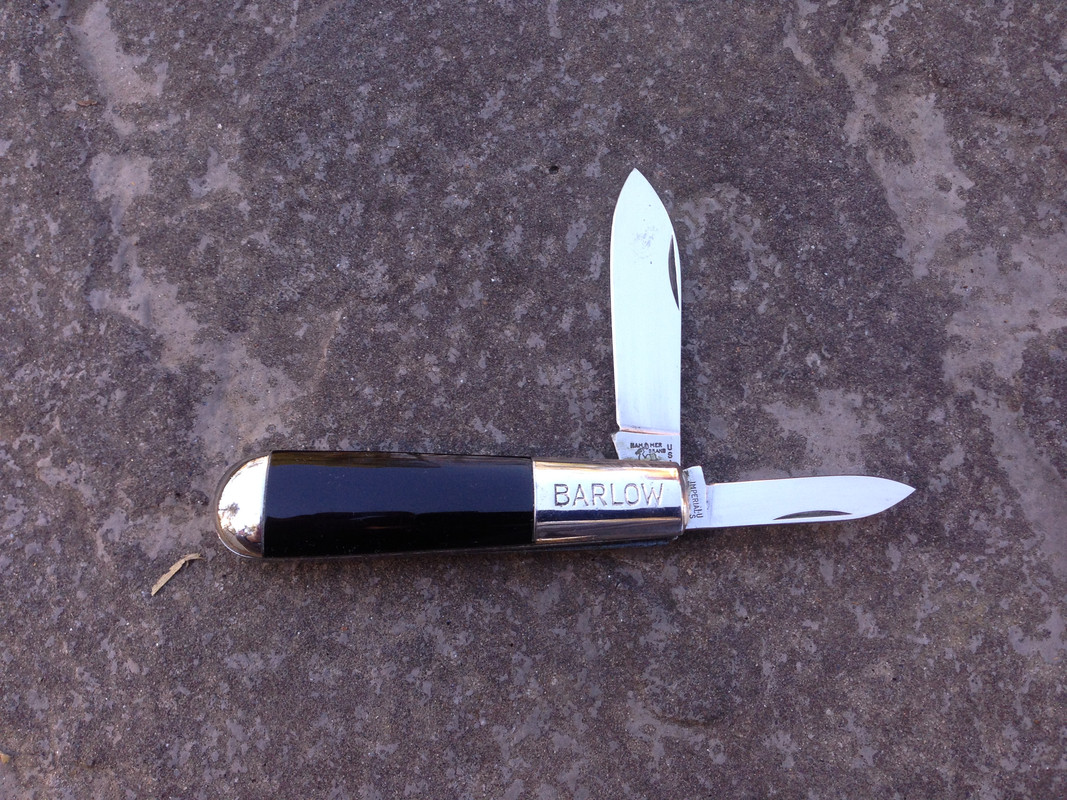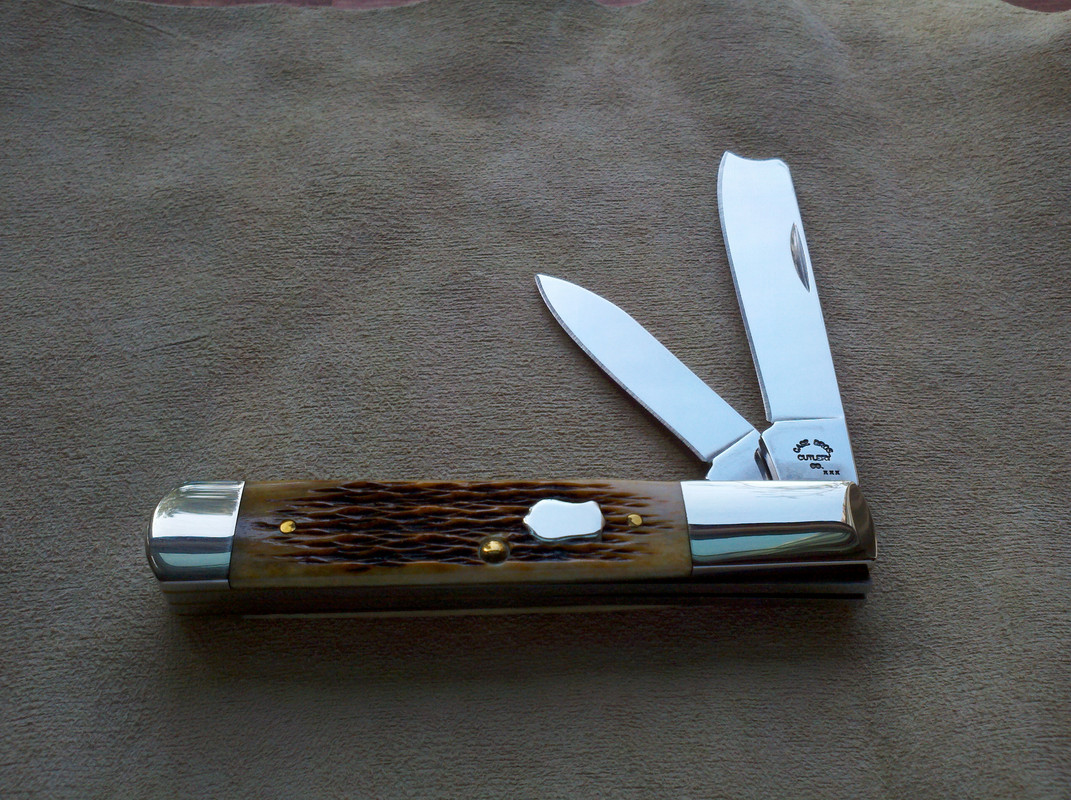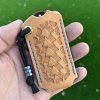-
The BladeForums.com 2024 Traditional Knife is available! Price is $250 ea (shipped within CONUS).
Order here: https://www.bladeforums.com/help/2024-traditional/
You are using an out of date browser. It may not display this or other websites correctly.
You should upgrade or use an alternative browser.
You should upgrade or use an alternative browser.
Blade Forums Spring Street Barlow (BF Knife 2021)
- Thread starter Magizm7
- Start date
- Joined
- May 13, 2019
- Messages
- 8,182
Old Hunter
Gold Member
- Joined
- Jul 12, 2012
- Messages
- 10,104
Do you have any barlows with end caps? I've never seen any myself.

Hammer Brand by Imperial USA.

Case 62005 1/2
Old Hunter
Gold Member
- Joined
- Jul 12, 2012
- Messages
- 10,104

Case Bros 62005 RAZ SS
Our family was once thought to be related to Captain Cook who led General wolf into Quebec you dont get anymore nearly Canadian than that.
Sunday saw the 250th anniversary of one of the most important battles in modern British history. In the early hours of 13 September 1759, a small British army was hauling itself and its guns up a cliff path. At the age of 32, Major General James Wolfe was attempting to manage in a few hours what he had failed to achieve in the last five months, the capture of city of Quebec. Quebec was the key to the conquest of New France, modern Canada.
When Wolfe and the army arrived in April, the French were not unduly daunted. France led the way in fortress building and the walls of Quebec were formidable. These walls and the natural barrier of the St Lawrence river had successfully beaten off British attacks in 1690 and 1711. Why should this time be any different? Over the next few months Wolfe ordered several direct assaults, all beaten back with great loss of life. By September many of the remaining troops were sick, Wolfe among them, and Admiral Saunders was preparing to take the fleet back to England before winter set in and the St Lawrence river froze over.
One bright prospect in all this gloom was a young Master James Cook of HMS Pembroke. Cook's sounding and surveying of the St Lawrence had led to the discovery that it was actually navigable by larger ships. Previously it had been thought that nothing larger than a frigate could get up river past Quebec itself. This meant the army could be landed further up river and the city attacked from behind, where its defences were less formidable.
With winter fast approaching, Wolfe was running out of time. Yet he was convinced his army could beat the French troops if he could just get them to come out and fight. On the night 12 September the troops embarked and began climbing up the cliff path to the open ground behind Quebec itself. The manuscript collection holds a copy of Wolfe's order book (ref GRE/2) and the orders for 12th September 1759 state:.
As the sun came up it is easy to imagine how astonished the French must have been to find a British Army drawn up on the open ground behind the city, blocking any retreat to Montreal. The orders continue:
The French commander Montcalm panicked and rushed out to attack Wolfe before the redcoats could land more men and consolidate their position. But Wolfe was right in one thing: his well drilled troops were more than a match for Montcalm's men. The log of the Pembroke (ref ADM/L/P/79) takes up the story:
Both Wolfe and Montcalm were killed in the battle, but their legacy is very much still with us. defeat at Quebec meant an end to New France and the French presence in North America. Free of the need for military protection, it was only 16 more years till the English colonies in North America were able to rebel against British rule and become United States of America. It is not usual to think of Wolfe as a nation builder but North America would not have been the same without him.
General Wolfe is buried at the church of St Alfeges in Greenwich and his statue stands outside the Royal Observatory, overlooking the Thames rather than the St Lawrence. (He lived in the Rangers House).
How is this about knives or the Bladeforum's knife?
BrotherJim
Gold Member
- Joined
- Feb 9, 2015
- Messages
- 4,246
At first I thought it was a smudge or some grease or something on the end of the blade at the tang, but it doesn't wipe off.
Maybe where the umbilical cord was before GEC turned this beauty loose !!!
... or a birthmark (beauty mark?)

Maybe where the umbilical cord was before GEC turned this beauty loose !!!
... or a birthmark (beauty mark?)

- Joined
- May 16, 2018
- Messages
- 4,183
Mine also shows the most change on the mark side,and shows the most in bright light. Although I'm certain my working conditions accelerated the processSo I have been carrying my BF knife everyday since I got it
On the mark side the bone appears more dense than on the pile side which is a bit more porous.
This most likely resulted in different penetration of the dyes.
The mark side is "wearing out" faster than the pile side in which the changes have been much less obvious.
Today I took these pics inside the home
Pile side

Mark side

Then outside in direct and very bright sunlight ... wow, that's different lol , it reminded me of pics from
Misplaced Hillbilly

I like both sides. The mark side has many subtle variation in red and dark tones
I wonder how the knife will age with prolonged use … which I planning to do.
I thought for a second about using some Fiebings black leather dye with a q tip to even them out ... but then decided to push that thought out of my brain
"Just leave it alone Dan" says I talking to myself
- Joined
- May 13, 2019
- Messages
- 8,182
Although I'm certain my working conditions accelerated the process

Johnnythefox
Gold Member
- Joined
- Feb 16, 2017
- Messages
- 4,694
Much as I love the knife and seeing them used.So I have been carrying my BF knife everyday since I got it
On the mark side the bone appears more dense than on the pile side which is a bit more porous.
This most likely resulted in different penetration of the dyes.
The mark side is "wearing out" faster than the pile side in which the changes have been much less obvious.
Today I took these pics inside the home
Pile side

Mark side

Then outside in direct and very bright sunlight ... wow, that's different lol , it reminded me of pics from
Misplaced Hillbilly

I like both sides. The mark side has many subtle variation in red and dark tones
I wonder how the knife will age with prolonged use … which I planning to do.
I thought for a second about using some Fiebings black leather dye with a q tip to even them out ... but then decided to push that thought out of my brain
"Just leave it alone Dan" says I talking to myself
I was having a good look at your shed,that looks like a big bowl or plate you are turning?
- Joined
- May 13, 2019
- Messages
- 8,182
Thanks Mark most educational.In regards to a Barlow having an end cap- There's an exception to every rule but it doesn't disprove the rule.
From Levine's Guide to Knives:


waynorth
Dealer / Materials Provider
- Joined
- Nov 19, 2005
- Messages
- 33,346
A wise and wonderful Post, Mark!! If we would all agreed to Bernie Levine's well-thought-out standards, we would eliminate a lot of useless controversy and blather!!In regards to a Barlow having an end cap- There's an exception to every rule but it doesn't disprove the rule.
From Levine's Guide to Knives:
Jsega51
Gold Member
- Joined
- Feb 11, 2015
- Messages
- 9,177
At first I thought it was a smudge or some grease or something on the end of the blade at the tang, but it doesn't wipe off.
Maybe where the umbilical cord was before GEC turned this beauty loose !!!
... or a birthmark (beauty mark?)

Forge scale, no need to remove it, it’s left behind from the tang being squared and flattened.
Johnnythefox
Gold Member
- Joined
- Feb 16, 2017
- Messages
- 4,694
where's the fun in that?A wise and wonderful Post, Mark!! If we would all agreed to Bernie Levine's well-thought-out standards, we would eliminate a lot of useless controversy and blather!!
You should try oil or tyre threads on the motorcycle forums they often lead to heated nonsense and a very close onset of WW3.
Johnnythefox
Gold Member
- Joined
- Feb 16, 2017
- Messages
- 4,694
By the way anyone when's the British sales of these opening up (he said innocently).
CelloDan
Basic Member
- Joined
- Dec 2, 2017
- Messages
- 3,377
Much as I love the knife and seeing them used.
I was having a good look at your shed,that looks like a big bowl or plate you are turning?
Thanks Johnny
Mounted on the lathe is my homemade Reverse Chuck. It allows you to turn the foot of your bowls/platters in a more elaborate way and also eliminate any "evidence" of how you attached the piece to the lathe.
It's an alternative for those turners, like me, that can not afford expensive lathes with vacuum chucks etc .

How it works ( not my pic )

Before I made it around 2010 I would just turn a recess in the foot ( as shown in the pic below ) and hold the piece with with the jaws of a chuck.
It is perfectly acceptable and most people would not notice or care. However if you hand the piece to another woodturner the first thing they do is flip it to examine the foot LOL ( you always get extra points for a foot that shows no evidence of how it was attached )

This one using the Reverse chuck


Johnnythefox
Gold Member
- Joined
- Feb 16, 2017
- Messages
- 4,694
Very interesting we made bowls when I was a kid at school,though all I can remember is some kids going to far and though the bottom.Thanks Johnny
Mounted on the lathe is my homemade Reverse Chuck. It allows you to turn the foot of your bowls/platters in a more elaborate way and also eliminate any "evidence" of how you attached the piece to the lathe.
It's an alternative for those turners, like me, that can not afford expensive lathes with vacuum chucks etc .

How it works ( not my pic )

Before I made it around 2010 I would just turn a recess in the foot ( as shown in the pic below ) and hold the piece with with the jaws of a chuck.
It is perfectly acceptable and most people would not notice or care. However if you hand the piece to another woodturner the first thing they do is flip it to examine the foot LOL ( you always get extra points for a foot that shows no evidence of how it was attached )

This one using the Reverse chuck

We did metal work,hammering sawing and the like I have the scars to prove it.
Nowadays in English schools I dont think they can do any of this stuff.
Very interesting and educational post, Dan! Thank you for sharing the info. I always love to see little “tricks of the trade”, even if it’s not my trade, as it just adds another something to draw on for creative problem solving with any woodworking projects I attempt.Thanks Johnny
Mounted on the lathe is my homemade Reverse Chuck. It allows you to turn the foot of your bowls/platters in a more elaborate way and also eliminate any "evidence" of how you attached the piece to the lathe.
It's an alternative for those turners, like me, that can not afford expensive lathes with vacuum chucks etc .

How it works ( not my pic )

Before I made it around 2010 I would just turn a recess in the foot ( as shown in the pic below ) and hold the piece with with the jaws of a chuck.
It is perfectly acceptable and most people would not notice or care. However if you hand the piece to another woodturner the first thing they do is flip it to examine the foot LOL ( you always get extra points for a foot that shows no evidence of how it was attached )

This one using the Reverse chuck



